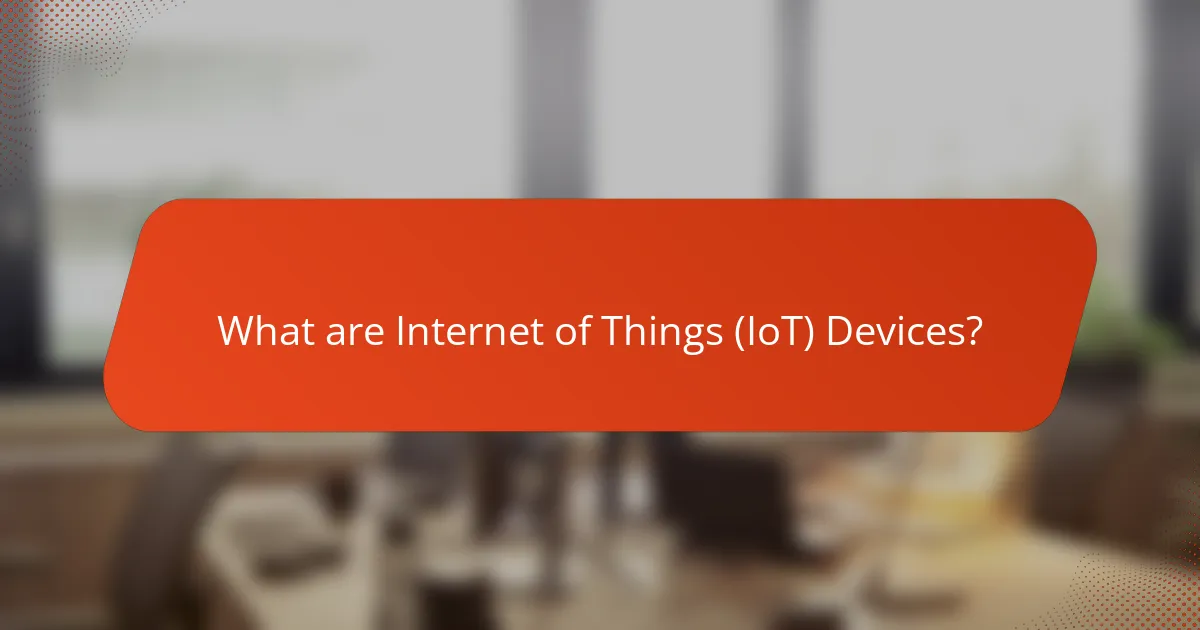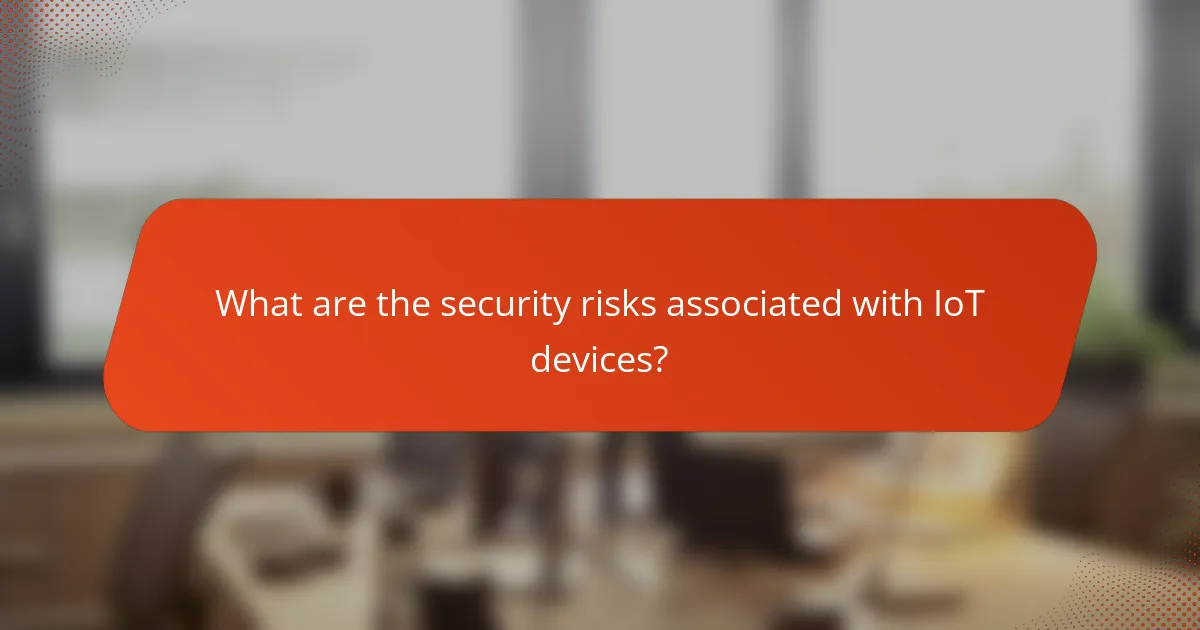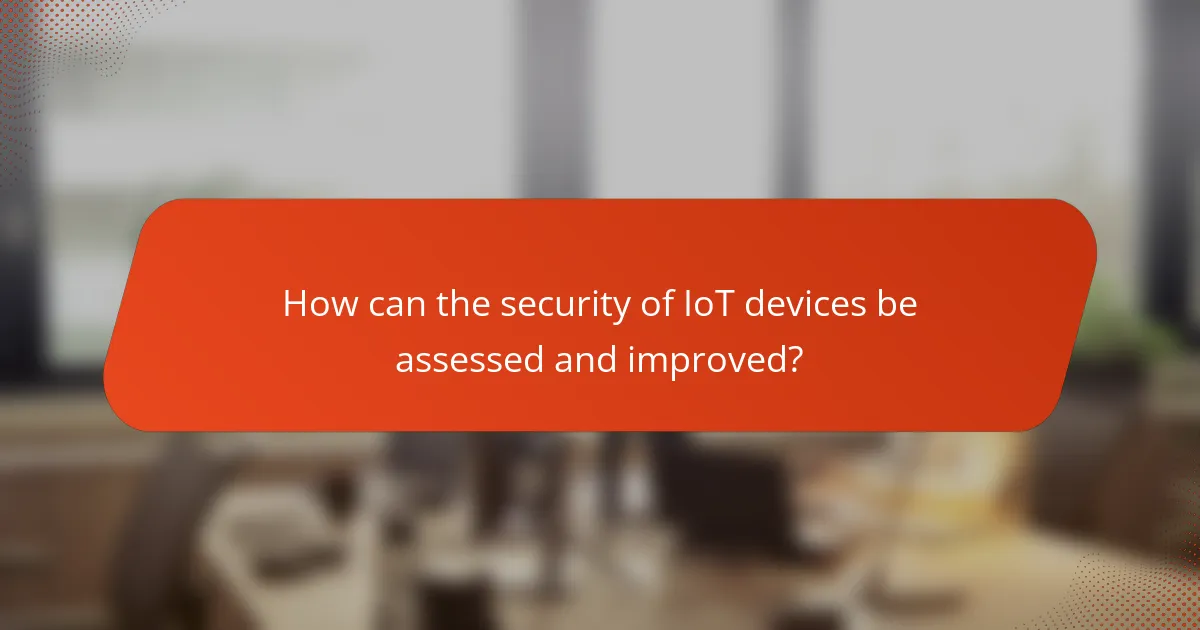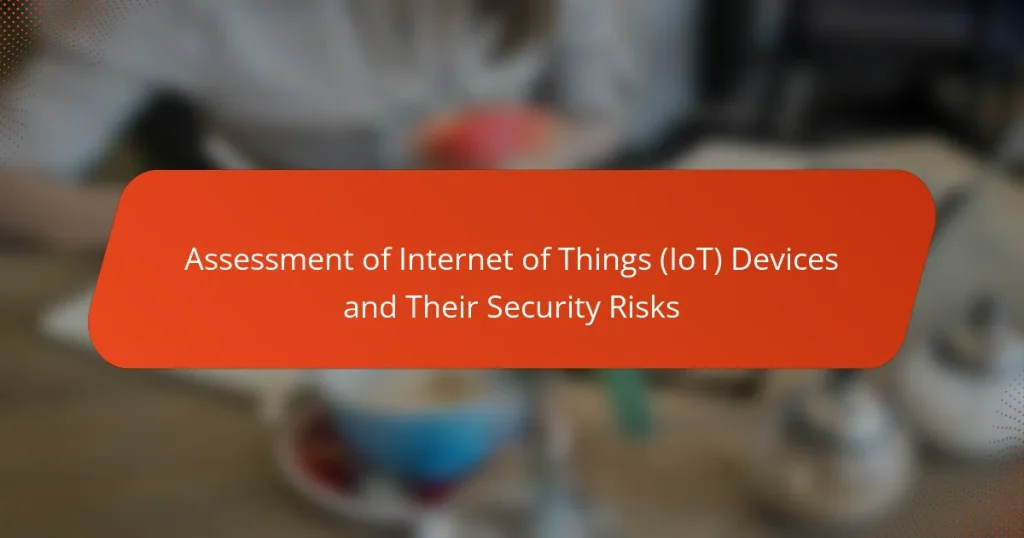The Internet of Things (IoT) refers to a network of interconnected devices that communicate over the internet to collect and exchange data, enhancing user experiences and automating processes. This article examines the various security risks associated with IoT devices, including unauthorized access, weak authentication, inadequate software updates, and poor encryption practices. Additionally, it outlines strategies for assessing and improving the security of these devices, such as conducting vulnerability assessments, implementing strong authentication measures, and educating users on best practices. As the number of connected IoT devices is projected to reach 30.9 billion by 2025, understanding and addressing these security challenges is essential for ensuring a secure IoT ecosystem.

What are Internet of Things (IoT) Devices?
Internet of Things (IoT) devices are interconnected gadgets that communicate via the internet. They collect and exchange data to enhance user experience and automate processes. Examples include smart thermostats, wearable fitness trackers, and connected home appliances. IoT devices utilize sensors and software to gather information from their environment. This data can be analyzed to improve efficiency and convenience. According to Statista, the number of connected IoT devices is expected to reach 30.9 billion by 2025. This growth highlights the increasing reliance on IoT technology in various sectors.
How do IoT devices function in everyday applications?
IoT devices function by collecting and transmitting data over the internet to enhance everyday applications. These devices use sensors to monitor environmental conditions or user behavior. They communicate data to centralized systems for analysis. This data can be processed in real-time or stored for future use. For example, smart thermostats adjust heating based on user preferences and external weather data. Smart home security systems detect motion and send alerts to users’ smartphones. Wearable fitness trackers monitor health metrics and sync data with health applications. The integration of IoT devices improves efficiency and convenience in daily tasks. According to a report by Statista, the number of connected IoT devices is expected to reach 75 billion by 2025, demonstrating their growing prevalence in everyday life.
What technologies enable the operation of IoT devices?
IoT devices operate using several key technologies. These include wireless communication protocols like Wi-Fi, Bluetooth, and Zigbee. These protocols enable devices to connect and communicate over networks. Additionally, cloud computing provides the necessary infrastructure for data storage and processing. Edge computing also plays a role by processing data closer to the source. Moreover, sensors and actuators are essential components that allow devices to interact with their environment. Security technologies, such as encryption and authentication, protect data and device integrity. Together, these technologies form the backbone of IoT device functionality.
How do IoT devices communicate with each other?
IoT devices communicate with each other primarily through wireless networks. They utilize protocols such as Wi-Fi, Bluetooth, Zigbee, and cellular networks. Each protocol offers different ranges and data transfer speeds. Wi-Fi allows high-speed data transfer over longer distances. Bluetooth is used for short-range communication and consumes less power. Zigbee is designed for low-power, low-data-rate applications. Cellular networks provide wide coverage and are suitable for mobile IoT devices.
Devices exchange data using Application Programming Interfaces (APIs). APIs define the methods and data formats for communication. This ensures interoperability between different devices. Additionally, IoT devices often connect to cloud platforms for data processing and storage. This enables remote access and control over devices.
Security protocols, such as encryption, are also essential for safe communication. They protect data from unauthorized access during transmission. Thus, IoT devices rely on a combination of protocols, APIs, and security measures to communicate effectively.
What are the different types of IoT devices?
There are several types of IoT devices. These include smart home devices, wearable devices, industrial IoT devices, and connected vehicles. Smart home devices encompass items like smart thermostats, security cameras, and smart lights. Wearable devices include fitness trackers and smartwatches that monitor health metrics. Industrial IoT devices are used in manufacturing and include sensors and automation equipment. Connected vehicles feature IoT technology for navigation, maintenance, and safety features. Each type of IoT device serves specific functions and contributes to the overall ecosystem of connected technology.
What are the key characteristics of consumer IoT devices?
Consumer IoT devices are characterized by connectivity, automation, and data collection capabilities. They connect to the internet and communicate with other devices. This connectivity enables remote control and monitoring through applications. Automation allows devices to perform tasks without user intervention, enhancing convenience. Data collection is essential for functionality, providing insights into user behavior and preferences. Many consumer IoT devices utilize sensors to gather information. Security is a critical concern, as vulnerabilities can lead to unauthorized access. According to a report by Gartner, by 2025, there will be over 75 billion connected devices globally, highlighting the prevalence of consumer IoT devices.
How do industrial IoT devices differ from consumer devices?
Industrial IoT devices differ from consumer devices primarily in their purpose and functionality. Industrial devices are designed for specific applications in sectors like manufacturing, energy, and transportation. They focus on real-time monitoring, automation, and data analytics to optimize processes. Consumer devices, on the other hand, cater to individual users for convenience and entertainment.
The operational environment of industrial IoT devices is often more complex and demanding. They must withstand harsh conditions such as extreme temperatures, vibrations, and electromagnetic interference. In contrast, consumer devices typically operate in stable environments like homes or offices.
Security requirements also vary significantly. Industrial IoT devices often handle sensitive operational data and require robust security measures. They are subject to strict regulatory compliance, unlike consumer devices, which may have more lenient security standards.
Furthermore, industrial IoT devices often have longer lifecycles and require more extensive maintenance compared to consumer devices. This is due to their critical role in operations and the investment involved. Overall, the differences stem from their intended use, operational conditions, security needs, and lifecycle management.

What are the security risks associated with IoT devices?
IoT devices face several security risks. These include unauthorized access, which can lead to data breaches. Weak authentication methods often make these devices vulnerable. Additionally, many IoT devices lack regular software updates, exposing them to known vulnerabilities. Poor encryption practices can also compromise sensitive data. Network attacks, such as DDoS, can exploit IoT devices to disrupt services. Privacy concerns arise when personal data collected by these devices is inadequately protected. Lastly, insecure default settings can leave devices open to exploitation. Together, these risks highlight the importance of robust security measures for IoT devices.
Why are IoT devices vulnerable to security threats?
IoT devices are vulnerable to security threats due to various factors. Many IoT devices have limited processing power and memory. This restricts their ability to implement robust security measures. Additionally, manufacturers often prioritize functionality over security during development. Many devices are shipped with default passwords that users do not change. This makes them easy targets for attackers. Furthermore, the lack of regular software updates leaves devices exposed to known vulnerabilities. A report by Cybersecurity & Infrastructure Security Agency highlights that many IoT devices lack encryption for data transmission. This increases the risk of data breaches and unauthorized access. Overall, these factors contribute to the heightened vulnerability of IoT devices to security threats.
What common vulnerabilities exist in IoT devices?
Common vulnerabilities in IoT devices include weak authentication, insecure communication, and outdated software. Weak authentication allows unauthorized access, as many devices use default or easily guessable passwords. Insecure communication can expose sensitive data, as some devices do not encrypt data transmissions. Outdated software can harbor known security flaws, making devices susceptible to attacks. Additionally, lack of regular updates can leave devices vulnerable to emerging threats. According to a 2021 report by Cybersecurity & Infrastructure Security Agency (CISA), these vulnerabilities are prevalent across various IoT devices, increasing the risk of exploitation.
How do these vulnerabilities lead to potential breaches?
Vulnerabilities in Internet of Things (IoT) devices can lead to potential breaches by allowing unauthorized access. Weak authentication methods enable attackers to gain control over devices. Insecure communication channels can expose sensitive data during transmission. Unpatched software vulnerabilities can be exploited to execute malicious code. Poorly designed interfaces may allow for unauthorized data manipulation. These factors increase the attack surface for cybercriminals. A report by Cybersecurity & Infrastructure Security Agency (CISA) highlights that 75% of IoT devices are vulnerable to attacks. This data underscores the urgency of addressing these security risks to prevent breaches.
What types of attacks are prevalent in IoT environments?
Common types of attacks in IoT environments include Distributed Denial of Service (DDoS) attacks, Man-in-the-Middle (MitM) attacks, and unauthorized access. DDoS attacks overwhelm devices with traffic, rendering them inoperable. MitM attacks intercept communication between devices, allowing attackers to steal data. Unauthorized access occurs when attackers exploit weak authentication to gain control over IoT devices. According to a 2021 report by Cybersecurity Ventures, IoT devices are expected to be involved in 75% of all DDoS attacks by 2025. Additionally, the 2022 IoT Security Report highlighted that 57% of organizations experienced MitM attacks targeting IoT devices. These statistics underscore the prevalence and risks associated with these attack types in IoT environments.
How do DDoS attacks specifically target IoT devices?
DDoS attacks specifically target IoT devices by exploiting their vulnerabilities and limited security features. Many IoT devices have weak authentication methods. Attackers can easily gain access and control over these devices. Once compromised, they can be used to generate massive amounts of traffic. This traffic overloads targeted networks or services, causing disruptions. For example, the Mirai botnet utilized compromised IoT devices to launch large-scale DDoS attacks. Research indicates that IoT devices often lack regular security updates. This makes them easy targets for attackers seeking to amplify their attacks.
What is the impact of unauthorized access to IoT networks?
Unauthorized access to IoT networks can lead to significant security breaches. This access allows attackers to control devices, manipulate data, and disrupt services. For instance, compromised smart home devices can be used for surveillance or unauthorized entry. Additionally, unauthorized access can result in the theft of sensitive personal information. A study by the Cybersecurity & Infrastructure Security Agency (CISA) highlights that 98% of IoT devices are vulnerable to attacks. This vulnerability underscores the importance of securing IoT networks to prevent unauthorized access and its detrimental impacts.

How can the security of IoT devices be assessed and improved?
The security of IoT devices can be assessed and improved through several key strategies. First, conducting vulnerability assessments is essential. This involves identifying potential security weaknesses in devices and networks. Regular software updates and patches can mitigate known vulnerabilities. Implementing strong authentication measures, such as multi-factor authentication, enhances device security. Network segmentation can limit the exposure of IoT devices to potential attacks. Additionally, using encryption for data transmission protects sensitive information. Monitoring network traffic can help detect unusual activities indicative of security breaches. Finally, educating users about security best practices is crucial for maintaining device security. These strategies collectively contribute to a more secure IoT ecosystem.
What methods are used to assess the security of IoT devices?
Common methods to assess the security of IoT devices include vulnerability scanning, [censured] testing, and security auditing. Vulnerability scanning identifies known security weaknesses through automated tools. [censured] testing simulates attacks to evaluate the device’s defenses against real-world threats. Security auditing involves reviewing the device’s architecture and code for compliance with security standards. These methods help organizations understand potential risks and improve device security. Studies show that regular assessments can reduce vulnerabilities significantly, enhancing overall IoT security.
How can [censured] testing be applied to IoT devices?
[censured] testing can be applied to IoT devices by simulating cyber attacks to identify vulnerabilities. This process involves assessing the device’s hardware, software, and communication interfaces. Testers use specialized tools to probe for weaknesses in the device’s security protocols. They analyze data transmission for encryption flaws and unauthorized access points. Additionally, physical security assessments may be conducted to evaluate tampering risks.
According to a report by the Internet of Things Security Foundation, over 70% of IoT devices are vulnerable to attacks due to inadequate security measures. Regular [censured] testing helps organizations ensure their devices comply with security standards and protect sensitive data. This proactive approach mitigates risks associated with IoT deployments and enhances overall security posture.
What role does vulnerability scanning play in IoT security?
Vulnerability scanning plays a crucial role in IoT security by identifying weaknesses in devices and networks. It systematically assesses IoT devices for known vulnerabilities. This process helps organizations understand their security posture. Regular scanning is essential due to the evolving threat landscape. Research indicates that 70% of IoT devices have security flaws. By detecting these vulnerabilities early, organizations can implement necessary patches or mitigations. This proactive approach reduces the risk of exploitation by malicious actors. Thus, vulnerability scanning is integral to maintaining robust IoT security.
What best practices can enhance IoT device security?
Implementing strong passwords is essential for enhancing IoT device security. Weak passwords are a common vulnerability in IoT devices. Users should create complex passwords that include letters, numbers, and symbols. Regularly updating these passwords further strengthens security.
Ensuring firmware is up-to-date is another critical practice. Manufacturers often release updates to patch security vulnerabilities. Users should enable automatic updates when possible. If not, they must check for updates regularly.
Network segmentation can also improve security. By isolating IoT devices on a separate network, users limit exposure to attacks. This strategy prevents unauthorized access to sensitive data.
Utilizing firewalls adds an extra layer of protection. Firewalls can monitor incoming and outgoing traffic. They help block suspicious activity targeting IoT devices.
Lastly, disabling unnecessary features enhances security. Many IoT devices come with default settings that may leave them vulnerable. Users should turn off features that are not in use, reducing attack surfaces.
How important is regular firmware updating for IoT devices?
Regular firmware updating is crucial for IoT devices. It enhances security by patching vulnerabilities. Cybersecurity threats evolve rapidly, making updates necessary. According to the Cybersecurity & Infrastructure Security Agency (CISA), unpatched devices are prime targets for attacks. Regular updates also improve device performance and functionality. A study by the Ponemon Institute found that 70% of IoT breaches stem from outdated firmware. Thus, maintaining up-to-date firmware is essential for safeguarding IoT devices against potential threats.
What measures can users take to secure their IoT networks?
Users can secure their IoT networks by implementing strong passwords and changing default credentials. Many IoT devices come with default usernames and passwords that are easily accessible online. Regularly updating device firmware is crucial for closing security vulnerabilities. Manufacturers often release updates to address identified risks. Users should also enable network encryption to protect data transmission. This adds a layer of security against eavesdropping. Segmenting the network can further enhance security by isolating IoT devices from critical systems. Firewalls can be configured to monitor and restrict traffic to and from IoT devices. Finally, users should regularly review connected devices and remove any that are no longer in use. This reduces potential entry points for attackers.
What are the future trends in IoT security?
Future trends in IoT security include enhanced encryption methods and AI-driven security solutions. These advancements will address the growing number of connected devices. With an estimated 75 billion IoT devices expected by 2025, robust security measures are essential. The integration of machine learning will enable real-time threat detection and response. Additionally, regulatory frameworks will evolve to enforce stricter security standards. The rise of edge computing will also decentralize security processes, reducing vulnerabilities. Furthermore, user awareness and education will become critical in mitigating risks. These trends are supported by the increasing number of cyberattacks targeting IoT devices, highlighting the urgent need for improved security measures.
How is artificial intelligence shaping IoT security solutions?
Artificial intelligence is significantly enhancing IoT security solutions. It enables real-time threat detection and response. Machine learning algorithms analyze vast data from IoT devices. This analysis identifies patterns indicative of security breaches. AI can adapt to new threats more quickly than traditional methods. For instance, a report by McKinsey highlights that AI can reduce response times by up to 90%. Additionally, AI-driven security solutions automate vulnerability assessments. They prioritize risks based on potential impact. This proactive approach strengthens overall security posture in IoT environments.
What emerging technologies are being developed to protect IoT devices?
Emerging technologies developed to protect IoT devices include blockchain, artificial intelligence (AI), and advanced encryption methods. Blockchain provides a decentralized approach to secure data transactions and device authentication. AI enhances security by detecting anomalies and potential threats in real-time. Advanced encryption methods, such as quantum encryption, offer higher levels of data protection against unauthorized access. Research indicates that these technologies significantly reduce vulnerabilities in IoT environments. For instance, a study by the National Institute of Standards and Technology (NIST) highlights the effectiveness of AI in identifying security breaches faster than traditional methods.
What are the key takeaways for securing IoT devices?
Key takeaways for securing IoT devices include changing default passwords. Default passwords are often easily guessable and widely known. Regularly updating firmware is crucial for fixing security vulnerabilities. Many manufacturers release updates to address known security issues. Implementing network segmentation helps isolate IoT devices from critical systems. This reduces the potential impact of a security breach. Using strong encryption for data transmission protects sensitive information. Encryption makes it difficult for attackers to intercept data. Monitoring device activity can identify unusual behavior or potential threats. Regular audits of IoT device security practices are essential for maintaining protection. These practices collectively enhance the overall security posture of IoT devices.
The main entity of the article is Internet of Things (IoT) devices, which are interconnected gadgets that communicate and exchange data over the internet to enhance user experience and automate processes. The article covers the functionality, types, and technologies behind IoT devices, as well as their vulnerabilities and security risks. It highlights the importance of robust security measures, including regular firmware updates, strong authentication, and network segmentation to protect against unauthorized access and attacks. Additionally, the article discusses future trends in IoT security, such as the integration of artificial intelligence and emerging technologies to mitigate risks associated with IoT devices.




